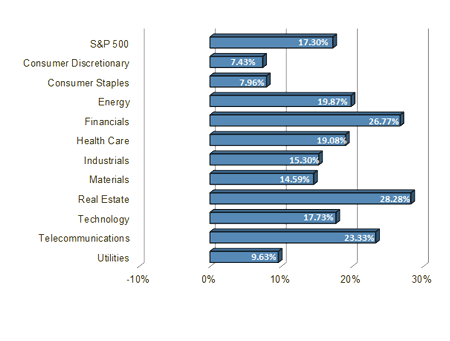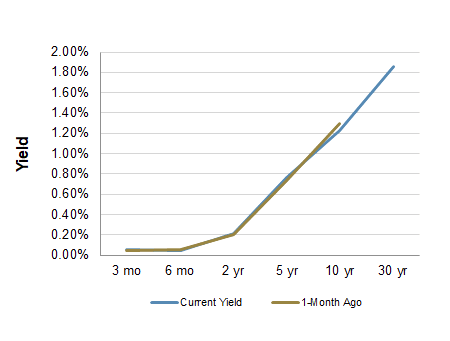Weekly Market Snapshot
Minutes of the June 27-28 Federal Open Market Committee (FOMC) meeting showed senior Fed officials to be divided on the outlook for tapering the monthly pace of asset purchases, with most officials expecting to start the process later this year (provided the economy evolves as anticipated), but several officials want to see more substantial improvement in labor market conditions.
Retail sales fell 1.1% in July (+21.1% y/y) while figures for May and June were revised higher. Sales remain around 12% above the pre-pandemic trend (that’s a lot). Industrial production rose 0.9% in July (+6.6% y/y), partly reflecting a seasonal quirk in autos (seasonal plant closings were more limited this year). Single-family building permits fell 1.7% in July to a 1.048 million seasonally adjusted annual rate (+5.5%). Housing starts, which are erratic, fell 7.0% (+2.5% y/y). Homebuilder sentiment fell five points (to 75) in August, reflecting ongoing supply constraints and affordability issues.
Next week: Investors will be looking for further clues on tapering in Fed Chair Powell’s Jackson Hole speech, but any formal decision on the timing and pace of tapering will come later (most likely at the September 21-22 FOMC meeting). The economic data calendar includes two timely gauges on the impact of the delta surge. UM consumer sentiment had already tumbled in the mid-month assessment. The CARTS data will indicate retail sales for the first half of August.
Indices
| Last | Last Week | YTD return % | |
|---|---|---|---|
| DJIA | 34,894.12 | 35,499.85 | 14.01% |
| NASDAQ | 14,541.79 | 14,816.26 | 12.83% |
| S&P 500 | 4,405.80 | 4,460.83 | 18.76% |
| MSCI EAFE | 2,309.06 | 2,341.81 | 7.52% |
| Russell 2000 | 2,132.42 | 2,244.07 | 7.98% |
Consumer Money Rates
| Last | 1 year ago | |
|---|---|---|
| Prime Rate | 3.25 | 3.25 |
| Fed Funds | 0.08 | 0.00 |
| 30-year mortgage | 2.93 | 3.06 |
Currencies
| Last | 1 year ago | |
|---|---|---|
| Dollars per British Pound | 1.3614 | 1.321 |
| Dollars per Euro | 1.1673 | 1.186 |
| Japanese Yen per Dollar | 128.07 | 125.48 |
| Canadian Dollars per Dollar | 1.290 | 1.319 |
| Mexican Peso per Dollar | 20.361 | 22.076 |
Commodities
| Last | 1 year ago | |
|---|---|---|
| Crude Oil | 62.53 | 42.58 |
| Gold | 1786.60 | 1946.50 |
Bond Rates
| Last | 1 month ago | |
|---|---|---|
| 2-year treasury | 0.21 | 0.20 |
| 10-year treasury | 1.23 | 1.30 |
| 10-year municipal (TEY) | 1.40 | 1.30 |
Treasury Yield Curve – 08/20/2021
As of close of business 08/19/2021
S&P Sector Performance (YTD) – 08/20/2021

As of close of business 08/19/2021
All expressions of opinion reflect the judgment of Scott Brown and are subject to change. There is no assurance any of the forecasts mentioned will occur or that any trends mentioned will continue in the future. Investing involves risks including the possible loss of capital. Past performance is not a guarantee of future results. International investing is subject to additional risks such as currency fluctuations, different financial accounting standards by country, and possible political and economic risks, which may be greater in emerging markets. While interest on municipal bonds is generally exempt from federal income tax, it may be subject to the federal alternative minimum tax, and state or local taxes. In addition, certain municipal bonds (such as Build America Bonds) are issued without a federal tax exemption, which subjects the related interest income to federal income tax. Municipal bonds may be subject to capital gains taxes if sold or redeemed at a profit. Taxable Equivalent Yield (TEY) assumes a 35% tax rate.
The Dow Jones Industrial Average is an unmanaged index of 30 widely held stocks. The NASDAQ Composite Index is an unmanaged index of all common stocks listed on the NASDAQ National Stock Market. The S&P 500 is an unmanaged index of 500 widely held stocks. The MSCI EAFE (Europe, Australia, Far East) index is an unmanaged index that is generally considered representative of the international stock market. The Russell 2000 index is an unmanaged index of small cap securities which generally involve greater risks. An investment cannot be made directly in these indexes. The performance noted does not include fees or charges, which would reduce an investor's returns. U.S. government bonds and treasury bills are guaranteed by the US government and, if held to maturity, offer a fixed rate of return and guaranteed principal value. U.S. government bonds are issued and guaranteed as to the timely payment of principal and interest by the federal government. Treasury bills are certificates reflecting short-term (less than one year) obligations of the U.S. government.
Commodities trading is generally considered speculative because of the significant potential for investment loss. Markets for commodities are likely to be volatile and there may be sharp price fluctuations even during periods when prices overall are rising. Specific sector investing can be subject to different and greater risks than more diversified investments. Gross Domestic Product (GDP) is the annual total market value of all final goods and services produced domestically by the U.S. The federal funds rate (“Fed Funds”) is the interest rate at which banks and credit unions lend reserve balances to other depository institutions overnight. The prime rate is the underlying index for most credit cards, home equity loans and lines of credit, auto loans, and personal loans. Material prepared by Raymond James for use by financial advisors. Data source: Bloomberg, as of close of business August 19, 2021.


